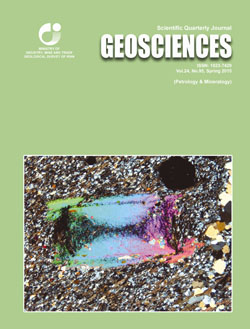Document Type : Original Research Paper
Authors
1 M. Sc. Student, Faculty of Basic Sciences, Tarbiat Modares University, Tehran, Iran
2 Associate Professor, Faculty of Basic Sciences, Tarbiat Modares University, Tehran, Iran
3 Assistant Professor, Faculty of Basic Sciences, Tarbiat Modares University, Tehran, Iran
Abstract
The Koshkoiye district is located in Dehaj-Sardoiye subzone of Uromieh-Dokhtar Magmatic Arc in Kerman region. There are five active mines including Palangi, Cheshmeh Khezr, Tale Dozi, Abedini, and Eghbali. The geometry of mineralization is strata-bound and hosted in the Eocene Pyrobitumen-bearing porphyritic andesite. Bornite, chalcocite and chalcopyrite are important Cu-sulfides together with hematite. The textures and structures of mineralization are open space filling, disseminated, vein-veinlet and replacement. According to geochemical study, tectonic setting of Koshkoiye copper district is extensional back-arc, which generated together with subduction of the Dehaj-Sardoiye subzone. Abundant of Cu, Pb and Ag elements is up to 600, 5 and 2 ppm in fresh porphyritic andesite. Fluid inclusion microtermometry indicates probably basinal brine source for ore-forming fluids. The copper mines in the Koshkoiye district have a lot of similarity in mineralogy, minor element, host rock, textures and structures, geometry and genesis with each other and the Manto-type copper mineralization of the world. This type of copper mineralization in the Koshkoiye district of Rafsanjan indicates the importance of volcanic processes in copper mineralization plus plutonic processes that produces porphyry systems in the Dehaj-Sardoiye subzone. The presence of pyrobitumen in porphyritic andesite host rock causes these deposits exposure in a few pyrobitumen-bearing andesitic hosted copper deposits of the world. There are only a few of these deposits in the world and dominantly located in Chile. Two important stages could be separated for mineralization in these deposits like the other Manto-type copper mineralization. The first stage includes processes, which caused to generate pyrite and pyrobitumen in matrix of porphyritic andesite and produced a reduction state in it. The Second stage was related to importance of generation of the Cu-rich oxidation fluids, which replaced the first stage pyrite and pyrobitumen by Cu-sulfides and hematite and caused copper mineralization.
Keywords

